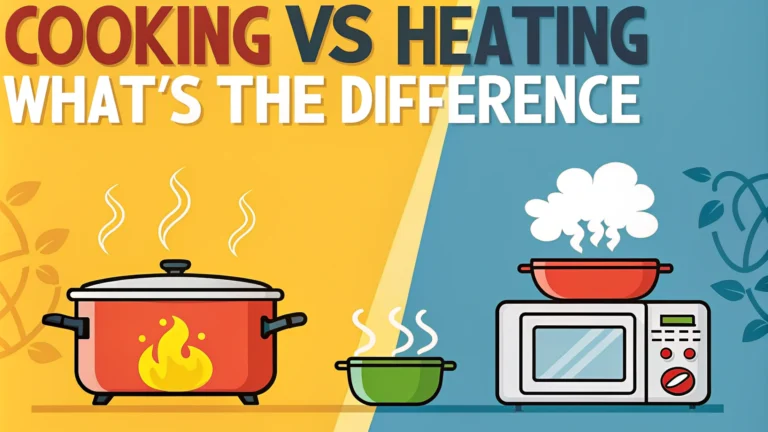Many people use the terms cooking and heating interchangeably, but these processes involve distinct scientific principles and produce different results in food preparation. While both methods add heat to food, cooking creates chemical changes that transform ingredients into new forms.
The main difference lies in the **molecular changes** that occur during each process. Heating simply raises the temperature of food, while cooking triggers reactions like protein denaturation, caramelization, and Maillard browning.
Key Differences Between Cooking and Heating
- **Chemical Changes**: Cooking alters food structure at molecular level
- **Temperature Control**: Cooking requires specific temperature ranges
- **Time Factor**: Cooking needs precise timing for reactions
- **End Result**: Heating warms food, cooking transforms it
Common Cooking Methods and Their Effects
| Method | Temperature Range | Chemical Changes |
|---|---|---|
| Baking | 300-450°F | Maillard reaction, caramelization |
| Sautéing | 320-400°F | Protein denaturation, browning |
| Steaming | 212°F | Protein changes, minimal browning |
When to Heat vs When to Cook
- **Heating**: Leftover meals, pre-cooked foods, ready-to-eat items
- **Cooking**: Raw ingredients, fresh produce, unprocessed meats
> “Understanding whether food needs cooking or just heating helps prevent overcooking and maintains food quality.”
Food Safety and Temperature Control
**Food safety** starts with proper temperature control. Each food type needs specific temperature ranges to kill harmful bacteria while maintaining quality and nutrients.
**Temperature danger zone** (40°F-140°F) creates ideal conditions for bacterial growth. Keep cold foods below 40°F and hot foods above 140°F.
Safe Temperature Guidelines
- Raw meats: Cook to minimum internal temperature of 145°F-165°F
- Reheated foods: Heat to at least 165°F throughout
- Cold storage: Keep refrigerator at or below 40°F
Equipment Selection and Best Practices
Choose the right tools for each heating or cooking method:
| Equipment | Best For | Tips |
|---|---|---|
| Microwave | Reheating, defrosting | Use microwave-safe containers, cover food |
| Oven | Cooking raw foods | Preheat fully, use middle rack |
| Stovetop | Direct heat cooking | Match pan size to burner size |
Time Management and Energy Efficiency
Smart timing saves energy and preserves food quality:
- **Batch cooking**: Cook multiple items at once
- **Preheating**: Only when needed for cooking, not heating
- **Size matching**: Use appropriate cookware for portion size
> “Efficient cooking and heating practices can reduce energy use by up to 30%”
Making the Right Choice for Better Results
Follow these guidelines for optimal food preparation:
- Check food labels for recommended heating/cooking instructions
- Use a food thermometer to verify proper temperatures
- Consider food texture and moisture content when choosing methods
- Plan ahead to avoid rushed cooking or improper heating
| Food Type | Recommended Method |
|---|---|
| Soups/Stews | Stovetop heating |
| Raw Vegetables | Steam or roast cooking |
| Leftovers | Microwave or oven heating |
Remember to always prioritize food safety while maintaining quality and nutritional value through proper cooking and heating techniques.
Cooking vs Heating FAQ
Basic Differences FAQ
Q: What is the fundamental difference between cooking and heating food?
A: Cooking involves chemical changes in food through heat application, transforming ingredients’ texture, flavor, and structure. Heating simply raises food temperature without significant chemical changes.
Q: At what temperature does cooking typically begin?
A: Most cooking processes begin around 140°F (60°C), when proteins start to denature. Simple heating can occur at any temperature above room temperature.
Technical Aspects FAQ
Q: Can microwaving food be considered cooking?
A: Microwaving can be both heating and cooking, depending on the temperature reached:
- Below 140°F: Just heating
- Above 140°F with protein/chemical changes: Cooking
Q: What methods are considered heating vs cooking?
A:
| Heating Methods | Cooking Methods |
|---|---|
| – Warming in microwave – Hot holding – Thawing |
– Baking – Frying – Roasting – Grilling |
Common Questions FAQ
Q: Does reheating leftovers count as cooking?
A: No, reheating leftovers is considered heating since the primary chemical changes already occurred during initial cooking.
Q: Why does heated food taste different from cooked food?
A: Cooked food undergoes Maillard reactions and caramelization, creating new flavors and aromas. Heated food only returns to its previous temperature without new chemical reactions.
Q: Does heating food in a sous vide count as cooking?
A: Yes, sous vide is cooking because it reaches temperatures that cause protein denaturation and chemical changes, despite its gentle heating method.
Safety and Nutritional FAQ
Q: Is heated food less nutritious than cooked food?
A: Not necessarily. Both processes can affect nutrients, but proper heating usually preserves more nutrients than high-temperature cooking methods.
Q: What’s safer: cooking raw meat or heating pre-cooked meat?
A: Heating pre-cooked meat is safer, as the initial cooking process has already killed harmful bacteria. However, both are safe when proper temperatures are reached.
Q: Can you get food poisoning from improperly heated food?
A: Yes. Food must reach 165°F (74°C) when reheating to kill any bacteria that may have grown during storage.
Q: Does meal prep require cooking or just heating?
A: Meal prep typically involves both:
- Initial cooking: Preparing ingredients
- Later heating: Warming for consumption



















